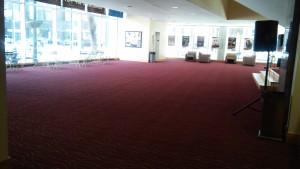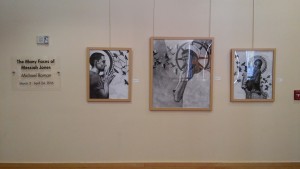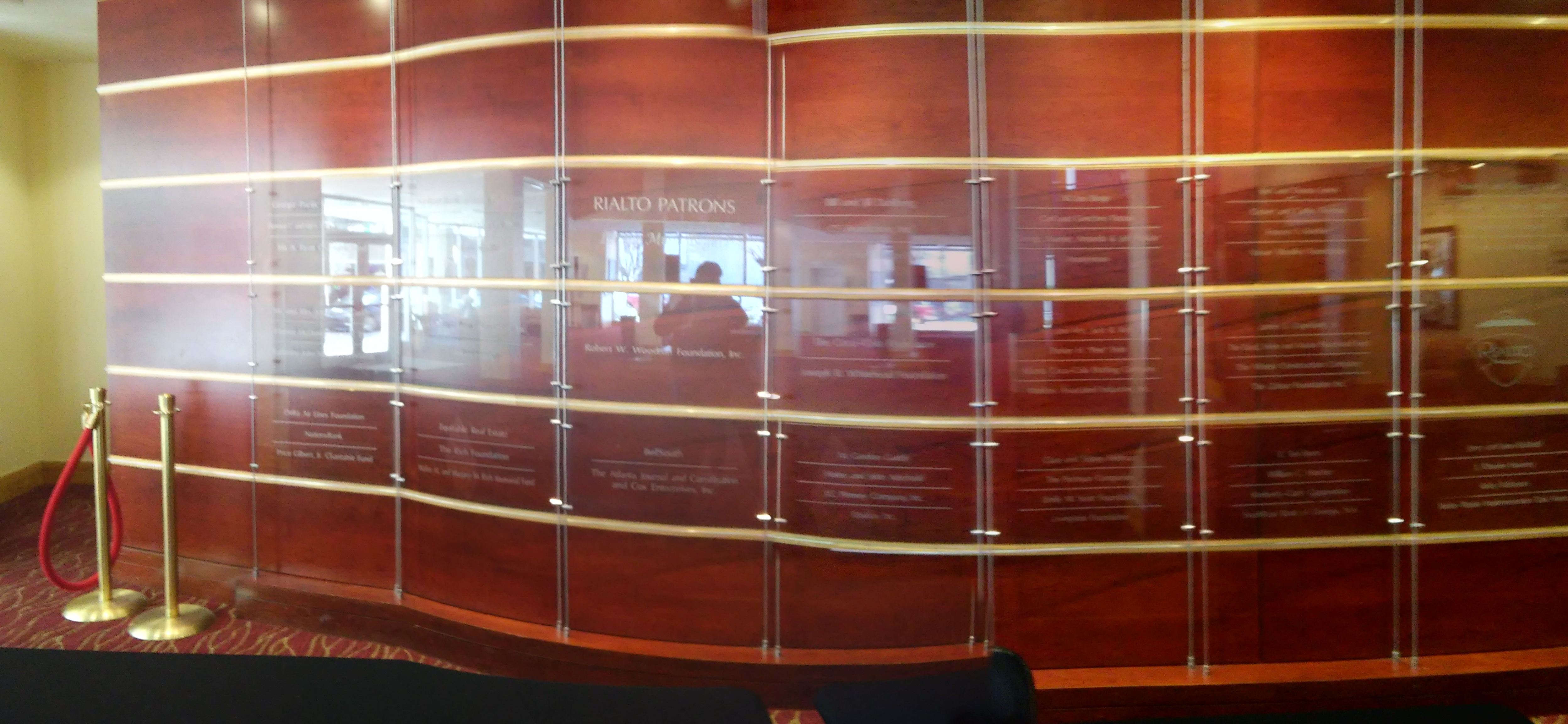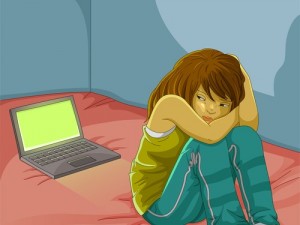The Rialto Center for the Arts
The Rialto Center for the Arts, located at 80 Forsyth St NW in Atlanta, and operated by Georgia State University, was first opened in 1916 and was originally a movie theater. In 1962, the building was torn down and rebuilt, staying open until 1989, when it was closed due to the economy. In 1994, the Rialto went under construction as was reopened in 1996 and is now run by Georgia State University.
When I first walked into the lobby, the first thing that I noticed was the carpet (see below). It looked burgundy or red with curved lines that looked gold or yellow.
Based on the carpet, I assumed the rest of the lobby would be pretty elegant and nice looking.
I walked further into the lobby, towards the wall straight ahead of me sat in one of the chairs, observing the lobby. The main thing that heard was music playing. It sounded like jazz and it seemed like it was not near where I was. By looking around, I found out it was coming from a speaker on the other side of the lobby.
There was a lot of open space in the lobby on both sides. Most of the lighting was natural light from the windows. I did not see many people, maybe two. I figured it was not very busy around the time that I was there, which was 12 pm. I assumed the open space would be convenient for large crowds on the nights that there are shows.
When I looked at the wall behind me I saw a collection of artwork called “The Many Faces of Messiah Jones” by Michael Roman. It was drawings in black and white. I assumed the black and white colors scheme was a theme throughout the collection. As I walked around the lobby, I noticed more drawings from the collections. There were even a few of them upstairs near the doors of the theater. These are some of the ones I saw on the first floor of the lobby:
- The name of the collection
- Here are more drawings on the other side of the lobby
Here are the drawings from the second floor:
Another thing that I saw on the first floor of the lobby was an area that looked like a history display for the Rialto. It was not visible when I first walked into the lobby. It was in the back of the lobby, hidden by the stairs leading up to the second floor. In this area, there were posters, pictures , and some artifacts. There were also a few chairs and a small table. I assumed it was for soemone to sit and look around at the walls of the area. One word that I kept seeing when I was looking at the display, was “Landmark”. It made me think that the atmosphere of the Rialto was supposed to kind of historical. The fact that I kept seeing this word made me feel like it was important. I also noticed that all of the people in the posters and pictures looked different. They seemed to be from different backgrounds and cultures. It very diverse, with not only race, but also gender. I thought that the display was interesting but it seemed like it was hidden because it was not visible to me when I first walked in.
Near the front of the lobby on the right side, there was a curved wall, made out of wood, with glass panels on it. On the panels are the names of the Rialto Patrons. There were several names on the wall panels. Some of the names that were on a panel alone and some were shared with other names. I assumed that the names with their own panels donated the most to the Rialto. The wall was near the front of the lobby and visible as soon as I walked in. I assumed that the wall was important to the owners of the Rialto center and that they wanted to show appreciation to the patrons.
Content Control Controversy : A Summary of Melissa King’s Article
In her article, “Better Online Living through Content Moderation”, Melissa King discuses the necessity of “content control features”, such as “block and ignore functions, content/trigger warnings, blocklists and privacy options”, on the internet and the “cultural opposition” against it. She explains that the these “tools” are helpful to “users [that] may suffer from PTSD and need to avoid topics and people that trigger their anxiety”. Kings argues that “nobody should be required to read or listen to content if they do not want to”.
She continues the article with talking about the oppositions raised against “content control”. The people against these “tools” retaliate by called the users of them “weak” and “too sensitive”. King suggests that the “opponents are creating a culture that pressures people to expose themselves to experiences far more catastrophic than they can handle” and that “it becomes entirely the victim’s problem when they are attacked online, no matter the situation, and they should ‘just deal with it'”. A common argument against “content control” is that the victims are just blowing things out of proportion and that “they should try being ‘less sensitive'”. King states that these arguments often result in an “informal parallel to Exposure Therapy”, which is “a type of therapy designed to combat severe anxiety through gradual and controlled exposure to its source, to inure an individual to these triggers and lesson the disruptions they can cause”. When people are discussing “content control” they often misinterpret the concept of “Exposure Therapy” and they fail to realize that “without controlled exposure, someone suffering from PTSD is likely to have their trauma magnified rather than reduced when faced with the triggering content”.
As she goes on, she provides more arguments against “content control”, such as the “myth” that when someone is harassed online, it is “merely mean words said on the internet, with no real threat to the safety or their family”. Some people do no believe that this harassment can cause PTSD because “according to popular culture, this is something only veterans suffer”. King disagrees with this idea and argues that it actually can. To support her argument she uses Caleb Lack, a clinical psychologist and psychology professor who specializes in treating anxiety disorders, as a source. She provides a quote from him saying:
“Bullying has long been known to have a severe impact on mental health, particularly if the bullying is repeated and prolonged… So, given what we know about PTSD, and given what we know about the effects of bullying (cyber and otherwise) on mental health, I think it’s relatively safe to say that “Yes, you can ‘get’ PTSD from Twitter.” One needs to be careful, though, to be specific about this: it’s the bullying and harassment that could lead to PTSD or PTSD symptoms (as well as depression, increased suicidality, and so on), not anything inherent to Twitter itself.”
Then, King discusses hate groups that are known for discouraging victims from the use of “content control”. One example of this is Gamergate, a group that is ” notorious for doing everything in its power to threaten people into silence– from calling and threatening family members, to posting pictures of their targets’ homes and addresses online”. She also argues that women are one of the main “targets” to online harassment when they are in “male dominated” areas, such as “the tech industry of in video game culture”. Two women that can testify to this are “Zoe Quinn (a video game developer and co-founder of Crash Override) and Anita Sarkeesian (creator of the YouTube channel ‘Feminist Frequency’ and the video series ‘Tropes vs Women in Video Games'”. She concludes the article with the argument that “people should be allowed to set their own personal boundaries and disregarding those personal boundaries should be seen as disrespectful at best”.
Color Walking
In Phia Bennin and Bredan McMullan’s article, “Color Walking”, They explain William Burroughs’s creative tool he used “to inspire students”, called color walks. They give instructions on how to do a color walk. You simply walk out of your door and pick a color. Then follow that color “from object to object” wherever it leads you. They also talk about their own experience with color walk, switching from color to color. There is also a diagram showing where they went and what colors they saw. The end the article with a few tips on how to make sure your color walk is successful. The tips include: “give yourself and hour of uninterrupted time…follow the [color] that makes your heart go thump-thump, [and] if you get lost, pick another color. If you get really lost, you’re on the right track”.














